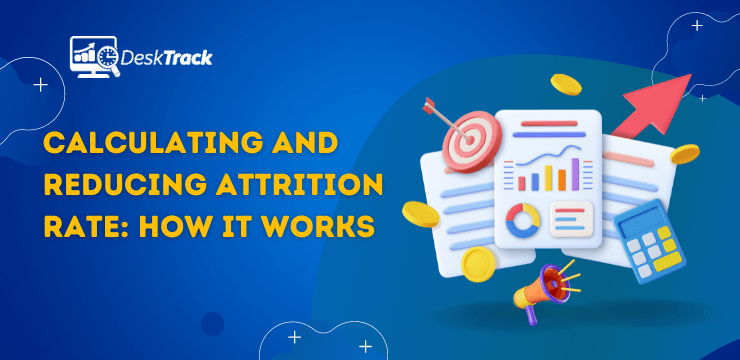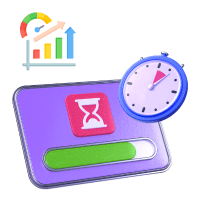
For the most accurate example, attrition and employee retention are like peas in a pod. Attrition is the peas and employee retention is the pod. Although they are not the same, they are correlated in a sense. Furthermore, the more good employees you retain, the better. So, in this blog, we will tell you how to reduce your organization’s attrition rate immediately.
What is the Attrition Rate?
Your organization’s attrition rate is a measure in %, where your employees leave without you getting an immediate replacement within a specific time. By this logic, the less it is, the better for your organization.
Furthermore, knowing that you can’t have a 0% attrition rate is essential. Why? Because employees will leave your organization for reasons including retirement, better job opportunities, and work environments.
However, you may also terminate your employees due to lack of experience or not adhering to work policies. Thus, we recommend you keep this rate at the bare minimum.
Attrition rate can significantly affect your business, so monitoring it is essential for your HR teams to improve workforce planning strategies and people management.
It may sound similar to the turnover rate. However, these two are different.

Key Differences Between Attrition and Turnover Rate
Both attrition and turnover rates are essential HR software and productivity metrics for your organization. These two are quite similar but have different metrics.
By definition, attrition rates occur when employees leave quicker than you can replace them. In such cases, vacancies stay open for extended periods. On the other hand, turnover rates refer to the new hires, which replace the ones, which leave your organization. However, both of these rates are related to employee retention.
Below we have explained the differences with examples for a better understanding.
|
Attrition Rate |
Turnover Rate |
| Retirement | Voluntary resignation |
| Contract termination | Involuntary termination |
| Downsizing |
Internal transfer |
So, these examples made clear the difference between the two, so we can keep the turnover rate aside for now. However, can there be more than one category of attrition rates?
Types of Attrition Rates
It is essential to know the attrition rate type as well. Why? It affects how well your company is doing in terms of employee management system. So, let’s get right into it.
Voluntary and Involuntary
The voluntary attrition rate is simple since it is related to resignation. In simple words, it’s when your employee decides to leave for any reason such as a better job opportunity. However, it is essential to analyze who is leaving.
It’s because you can’t let your top performers resign as it can greatly decrease productivity in the long run. However, the latter is when your organization lets an employee go.
Functional and Dysfunctional
Dysfunctional attrition is bad for your organization as it is related to employees resigning because of toxic work culture, mismanagement, and low morale. However, the latter defines loss of employees due to non-adherence. It’s not that bad. However, you should still check whether your policies are compilable.
Read Also: Time Card Calculator: A Complete Guide
How to Calculate Attrition Rate?
First, here’s the formula.
- Attrition rate = (no of employees leaving)/(average employees)*100.
This is how it works.
- Set a specific timeframe. Add the total employees at the start and end of this time and divide by 2.
- Then put everything in the formula and you are done.
For example: 100 out of 200 employees leaving is a 50% attrition rate. It means you need to work a lot to improve your workplace environment.
Factors That Affect Attrition Rates
Similar to turnover rates, many factors affect attrition rates. The objective is to balance these factors to have attrition rates as low as possible.
Compensation
Your employees need to get fair compensation for their hard work. This keeps them inspired to work with more and more dedication for your organization. Here, fair compensation can be beyond optimal salary payments. It can also include:
- Salary hikes and bonuses.
- Appraisals and other rewards.
- Extra time off and other forms of appreciation.
Overall, fair compensation ensures that your employees stay longer in your organization. Furthermore, it also ensures more employee engagement and the will to improve. However, this is not the only reason to retain employees.
Job Satisfaction
A universal fact is that fair compensation is useless if your employees are not satisfied with your organization. This can be due to a toxic work culture, employee bias, internal jealousy, lack of motivation, or any other reason. Thus it’s essential to identify your employees’ pain points, eliminate them, and increase job satisfaction. This will result in a low attrition rate.
Learning and Development
You can’t expect a low attrition rate if your employees aren’t getting enough opportunities to learn and grow. You can’t also expect freshers who just graduated to give you the highest productivity. That would be stupidity at its maximum. So, it’s obvious for more employees to be where there are more learning and development opportunities. Whether it’s yours or your competitors’ businesses.
Workforce Demographics
For example, if your organization is forecasting many employees to retire in a few years, we recommend you take steps to adjust the attrition rate, ensuring that it’s not too high. For example, you can:
- Redistribute the responsibilities.
- If the designation is not relevant anymore, you can wait for your employees to retire.
Shift in Sectors
For example, you will need less retail staff, if you are reducing shops. This will lead you to hire more employees who can handle e-commerce because you will then sell your products and services online. This automatically affects attrition rates a lot. So, it’s essential to not shift industries more frequently.
Financial Conditions
Simply put, when business is booming, you will hire more people and offer more salary hikes. However, when it’s not, especially during the times when customers don’t shop much, you will pause hiring and cut back on your employees’ salaries. This can also make attrition rates high. So you need to balance this factor as well.
Conclusion
Employee attrition rate is the measure of the percentage of the frequency of your employees leaving whether voluntarily, involuntarily, functionally, or dysfunctionally. Tracking this rate lets you identify how well your HR team is at people management and planning. It’s essential to keep this rate low. Especially, when it comes to keeping your star performers. To calculate this rate there is a specific formula, which can be affected by many factors including compensation, job satisfaction, and industry shifts. Now with all this at stake, you would want to retain all the good employees. We recommend using DeskTrack for the best results.
Frequently Asked Questions (FAQ)
Q. What is the Attrition Rate?
Ans. Your organization’s attrition rate is a measure in %, where your employees leave without you getting an immediate replacement within a specific time. By this logic, the less it is, the better for your organization. Attrition rate may occur when you either terminate your employees or they decide to leave your organization.
Q. What is the Difference Between Attrition and Turnover Rate?
Ans. In simple terms, the attrition rate is the % measure at which employees in your company leave faster than you can replace them. On the other hand, the turnover rate is the measure of new hires replacing the old ones in your organization. However, both of these rates are related to employee retention. Below, we have given a few examples of these.
Attrition:
- Retirement
- Contract termination
- Downsizing
Turnover:
- Voluntary resignation
- Involuntary termination
- Internal transfer
Q. How Many Types of Attrition Rates Are There?
Ans. Attrition rates and employee retention are correlated. Thus, knowing how it works is essential for your business. Based on whether your employee decides to leave or you let them go, there are four types of attrition rates.
- Involuntary
- Voluntary
- Functional
- Dysfunctional
Q. What are the Factors that Affect Attrition Rate?
Ans. Similar to turnover rates, many factors affect attrition rates and employee retention in your organization. Based on this, we shortlisted several factors affecting this rate in your business.
- Compensation
- Job satisfaction
- Learning and development
- Workforce demographics
- Shift in sectors
- Financial conditions










